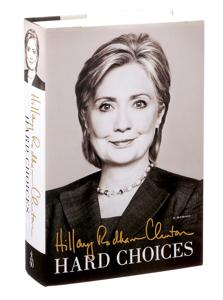
Want to learn the ideas in Hard Choices better than ever? Read the world’s #1 book summary of Hard Choices by Hillary Rodham Clinton here.
Read a brief 1-Page Summary or watch video summaries curated by our expert team. Note: this book guide is not affiliated with or endorsed by the publisher or author, and we always encourage you to purchase and read the full book.
Video Summaries of Hard Choices
We’ve scoured the Internet for the very best videos on Hard Choices, from high-quality videos summaries to interviews or commentary by Hillary Rodham Clinton.
1-Page Summary of Hard Choices
Overview
The Audacity of Hope is based on a speech that Barack Obama delivered at the 2004 Democratic Convention. The speech launched him into the spotlight and led to his campaign for presidency in 2008.
In Hard Choices, Hillary Clinton describes the Obama administration’s shift to “smart power,” a combination of soft power (like diplomacy) and hard power (military intervention). As Secretary of State, she oversaw this strategic shift in American foreign policy. Although it was a difficult time for America in general, these key points explain how she handled difficult relationships with China and Iran while improving ties with Mexico and Japan. You’ll also get an idea of what Hillary Clinton would do differently if elected president. After reading these key points, you’ll learn why US foreign policy has shifted toward Asia; how Hillary Clinton thinks about the Benghazi incident; and her plans for women’s rights as president.
Big Idea #1: Obama’s administration focused on strengthening relations with Asia.
The United States’ foreign policy shifted focus from the Middle East to Asia-Pacific when President Obama assumed office. The administration was eager to reassert US power in the region, and sought nurturing relationships with important allies such as Australia, Japan and South Korea. In addition, there are huge economic opportunities for the US in this region because of booming economies across Asia.
Emerging powers like Malaysia and Indonesia are interesting to the US because they’re democratic.
In contrast, North Korea continues to threaten the world with its nuclear weapons and China is a rising power in East Asia that needs to be balanced.
Seeing the need for a political solution to Asia’s economic problems, the Obama administration has proposed a trade agreement with Latin America and Asia. The Trans-Pacific Partnership (TPP) is designed to lower trade barriers and raise labor standards, protect the environment, and enforce intellectual property rights. At this time negotiations over TPP are still ongoing.
The United States has also been engaging in ASEAN (Association of Southeast Asian Nations) and other multilateral organizations, as well as flexing its military muscle by deploying the USS George Washington to Asia due to North Korea’s threats against South Korea.
Furthermore, the administration met with Japanese leaders 14 times in 2010 and offered assistance to them after a devastating earthquake. In fact, Clinton’s first trip as secretary of state was to East Asia; she visited the Pacific Region 36 times during her first three years. She made seven trips to China alone because it posed quite a challenge diplomatically.
Big Idea #2: The United States has had to balance its own interests and values in dealing with China.
Imagine you own a company. You need money to run your business, but one of the people who lends you that money is also very strict and threatens everyone in town. How do you deal with this person? That’s essentially what the United States has been dealing with when it comes to China.
America and China have a lot in common. They both worry about nuclear weapons, terrorism, and economic growth. However, because of the differences in their governments, they don’t always agree on how to handle these issues. For example, America is concerned about human rights violations in China and has been known to criticize them for it.
China also has territorial ambitions. In 2013, China suddenly declared an “air defense identification zone” over a large portion of the East China Sea. This was not Chinese territory, and they had no right to do so. The Obama administration deals with this complicated relationship by focusing on common ground while not forgetting the points where American and Chinese interests diverge.





